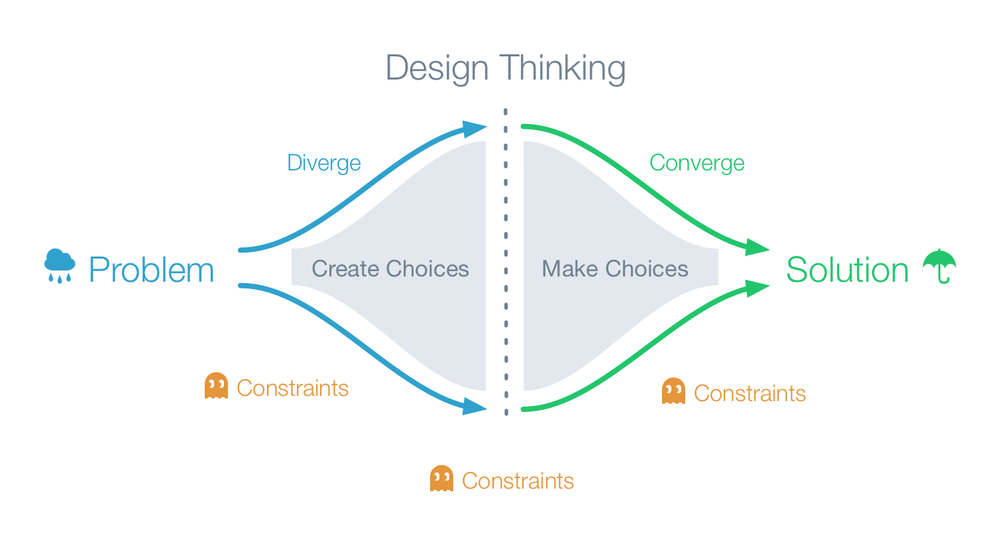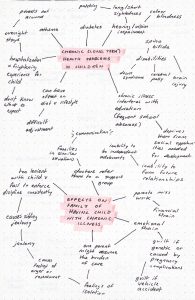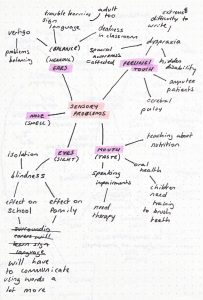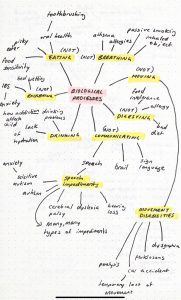This week we were put into groups for the beginning of our next project. This was so we could all get as much research out of the start of the project as possible – healthcare is a vast topic to cover, and so splitting the work load between people in a team is the best strategy to go about looking into it.
We decided in our team to create a miro board, where we could see all the research links we used collectively at a glance:

DIVERGENT THINKING IN WEEK 1:
After looking at the double diamond design model, I now understand the importance of divergent and then convergent thinking within projects – especially the research and discovery phase. Because we are in the first part of this phase it means I should have a diverging way of thinking – where I should be exploring every aspect of the project, (this will be helped through many people working on the research phase and therefore a spread out work load). Exploring as much as possible will allow me to have the best understanding of the matter as a whole, so I can make an informed decision (convergent thinking) about which are the biggest problems that need solving within the industry.
To conclude, this week is about creating choices, and next week will be about making choices.

DIVIDING THE SUBJECT MATTER IN OUR TEAM:
As a result of such a broad subject matter, we decided in our group to divide it up via age groups (babies, children, teens, adults (including healthcare professionals), and the elderly);
I chose to research childrens healthcare as I felt it was an interesting stage of life. After doing a children’s app last year I understood that after every 2 years or so, there were huge developmental changes, and that it was impossible to just “design for children” as ages 4-6, 7-9, and 10-12 had entirely different needs.

BRAINSTORMING & RESEARCHING ONGOING (CHRONIC) CONDITIONS THAT CHILDREN COMMONLY FACE:
I used this website to educate myself on some of the effects and problems that children with chronic illnesses and their family members face. It really helped me to gain an insight into some of the things families go through, and allowed me to start thinking about how design could maybe help solve some of these issues.
I created a mind map so I could display my findings in a visually understandable way for myself and my team members:

BRAINSTORMING AND RESEARCHING MODERN DAY HEALTH THREATS TO CHILDREN:
I used this website to understand this topic a bit better. I again, used a mind map so me and my team members could refer back to the information easily.

BRAINSTORMING USING VISUALS:
I had the idea of looking at a diagram of the human body, and seeing if it would help me to come up with ideas. I actually found that in doing this, I was able to come up with a few ideas that I hadn’t previously thought about before.

BRAINSTORMING AND VARIOUS SENSORY PROBLEMS CHILDREN MAY HAVE:
Doing the diagram above made me think of the nervous system specifically, and the problems it may have.

BRAINSTORMING AND RESEARCHING REGULAR BIOLOGICAL PROCESSES THAT THE BODY DOES:

BRAINSTORMING AND RESEARCHING CHILDREN’S MENTAL HEALTH PROBLEMS:
After using mind maps so many times, I began to realise they were most effective when given a key. The branches are a lot easier to think of when they’re given meaning like the following:

ASKING PARENTS WHICH HEALTH PROBLEMS THEY HAVE HAD DIFFICULTY DEALING WITH WITH THEIR CHILDREN IN THE PAST:
I did this so I could gain an insight into some common health problems in children, as well as how and why the parents struggled with either diagnosis or treatment specifically. A digital product could easily be used to help with many of these issues in the future:
-vaccinations
- false information circulated at the same time regarding MMR vaccinations linked to autism
- child was nervous or got upset about vaccinations
-excema was extremely difficult to deal with – would scratch until bleeding
- took the child off dairy and that helped
- steroid creams but doesn’t deal with root of problem
- swimming pool water helps kill the bacteria that causes eczema
-eye prolems
- regular eye tests with orthoptist in hospital
- did eye patching in order to strengthen the weaker eye
- very very regular checkups on how patching was helping
- regular lens changes
- child hated patching and cried multiple times
- some children start it earlier depending on how bad the eye is (one parent said their child started at 2 years old)
-frequent tummy bugs
- happened roughly once a year for each child
- for one child it didn’t improve, and almost needed hospitalisation due to unawareness of the need for calpol to bring down temperature
-chicken pox
- accidentally gave child ibuprofen (makes them worse)
- there should be more awareness to give them only paracetamol to help with pain
-unaware of allergy to penicillin
- child was given penicillin twice before doctors and parents realised them being sick wasn’t to do with the illness, but rather a common allergy to penicillin